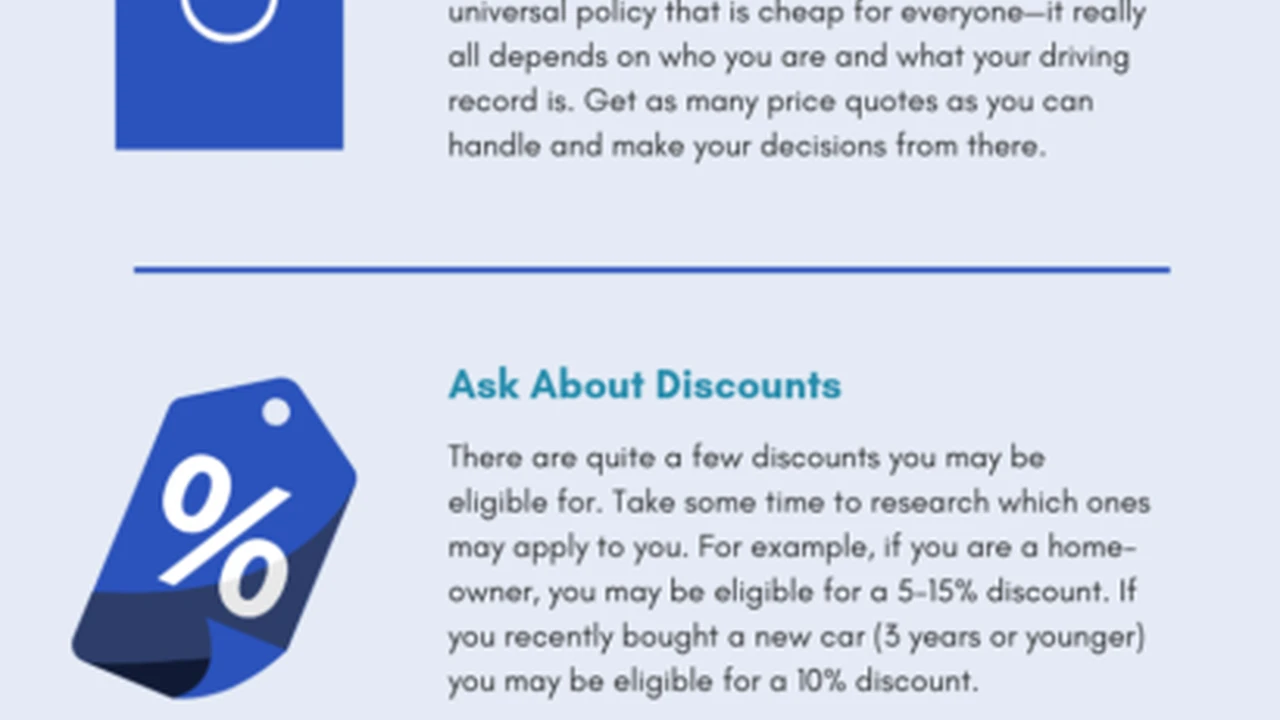5 Common Auto Insurance Discounts You Might Be Missing
Uncover 5 common auto insurance discounts you might be missing. Save money on your car insurance by checking for these valuable savings.

Uncover 5 common auto insurance discounts you might be missing. Save money on your car insurance by checking for these valuable savings. Let's dive deep into how you can significantly reduce your auto insurance premiums by simply knowing what to look for and asking the right questions. Many drivers pay more than they need to because they're unaware of the myriad of discounts available. This isn't just about finding a cheaper policy; it's about optimizing your current one or making an informed switch to a provider that truly values your loyalty and safe driving habits. We'll explore not just the discounts themselves, but also how they work, who qualifies, and how to effectively claim them. Think of this as your personal guide to unlocking hidden savings and making your auto insurance work harder for your wallet.
5 Common Auto Insurance Discounts You Might Be Missing
Unlocking Savings Understanding Auto Insurance Discounts
Auto insurance can be a significant recurring expense, but it doesn't have to break the bank. Insurance companies offer a wide array of discounts designed to reward safe drivers, loyal customers, and those who take proactive steps to reduce risk. However, these discounts aren't always automatically applied. It's often up to you, the policyholder, to inquire about them and ensure you're receiving every possible saving. This section will lay the groundwork for understanding why these discounts exist and how they benefit both you and the insurer.
Insurance companies operate on risk assessment. The less risk you pose, the more likely they are to offer you a lower premium. Discounts are essentially incentives for behaviors that reduce this risk. For example, a safe driver discount rewards those with a clean driving record, indicating a lower likelihood of future claims. Similarly, bundling policies reduces administrative costs for the insurer, a saving they can pass on to you. By understanding this fundamental principle, you can better position yourself to qualify for and claim these valuable reductions.
Discount 1 Multi-Policy Bundling Discounts for Comprehensive Coverage
One of the most widely available and often most substantial discounts is the multi-policy discount, commonly known as bundling. This discount is offered when you purchase two or more insurance policies from the same provider. The most common combination is auto and home insurance, but it can also extend to renters, motorcycle, boat, or even life insurance policies. The savings from bundling can range anywhere from 5% to 25% on your total premium, making it a powerful tool for cost reduction.
How Multi-Policy Bundling Works
When you bundle policies, the insurance company benefits from increased customer loyalty and reduced administrative overhead. Instead of managing separate accounts for different types of insurance, they consolidate your information, leading to efficiency gains. These savings are then shared with you in the form of a discount. It's a win-win situation: you save money, and the insurer retains your business for multiple products.
Who Qualifies for Bundling Discounts
Virtually anyone who needs more than one type of insurance can qualify. If you own a car and a home, or a car and rent an apartment, you're a prime candidate. Even if you only have a car and a motorcycle, many insurers will offer a multi-vehicle discount that functions similarly to a multi-policy discount. The key is to have multiple active policies with the same company.
Claiming Your Bundling Discount
Often, when you get a quote for multiple policies from the same insurer, the bundling discount will be automatically applied. However, it's always wise to explicitly ask your agent or check your policy documents to ensure it's included. If you already have separate policies with different companies, it's worth getting a quote from one of your current providers for all your insurance needs. You might be surprised by the savings.
Product Comparison: Bundling Options from Leading Insurers
Let's look at some popular insurers and their bundling offerings:
- GEICO: Known for its competitive rates, GEICO offers significant discounts for bundling auto with home, renters, or even motorcycle insurance. Their online quote system makes it easy to see potential savings upfront.
- State Farm: A long-standing insurer, State Farm provides excellent multi-policy discounts, often combining auto with home, life, or health insurance. They emphasize personalized service through their agent network.
- Progressive: Progressive's 'Name Your Price' tool can help you find bundling options that fit your budget. They offer discounts for combining auto with home, renters, or even RV insurance.
- Allstate: Allstate offers a 'Multi-Policy Discount' for combining auto with home, renters, condo, or life insurance. They also have a strong local agent presence for personalized advice.
- Liberty Mutual: Liberty Mutual provides discounts for bundling auto with home, renters, or even umbrella insurance. They often have promotions for new customers who bundle.
Scenario: John, a homeowner with a car, pays $150/month for auto insurance with Company A and $80/month for home insurance with Company B. He gets a quote from Company A for both policies, which comes out to $130/month for auto and $70/month for home, totaling $200/month. This is a $30/month saving, or $360 annually, just by bundling.
Discount 2 Safe Driver and Good Driver Discounts Rewarding Responsible Habits
Insurance companies love safe drivers because they represent a lower risk of claims. Consequently, they offer attractive discounts to those with clean driving records. These discounts are often referred to as 'safe driver' or 'good driver' discounts and can significantly reduce your premiums.
Defining a Safe Driver
While the exact criteria vary by insurer and state regulations, a safe driver typically means someone who has been accident-free and violation-free for a specified period, usually three to five years. This includes no at-fault accidents, no speeding tickets, and no DUIs. Some insurers might also consider minor infractions, but generally, a clean record is the key.
How Telematics Programs Enhance Safe Driver Discounts
Many modern insurance companies offer telematics programs, which use devices or smartphone apps to monitor your driving habits in real-time. These programs track factors like mileage, speed, braking habits, and time of day you drive. By participating, you can often earn additional discounts beyond the standard safe driver discount, as the insurer gets a more accurate picture of your actual risk.
Claiming Your Safe Driver Discount
If you have a clean driving record, this discount might be automatically applied when you get a quote. However, it's always best to confirm with your agent. For telematics programs, you'll need to opt-in and typically drive for a trial period (e.g., 90 days) to demonstrate your safe habits before the discount is applied.
Product Comparison: Telematics Programs for Safe Drivers
- Progressive Snapshot: One of the pioneers in telematics, Snapshot uses a device or app to monitor driving. Discounts can be substantial for safe drivers, with an average saving of $150 per year.
- State Farm Drive Safe & Save: This program uses a smartphone app or OnStar to track driving. Customers can save up to 30% based on their driving behavior.
- Allstate Drivewise: Drivewise uses an app to provide feedback on driving habits and offers cash rewards and discounts for safe driving.
- Liberty Mutual RightTrack: RightTrack uses a plug-in device or mobile app. Participants can save up to 30% on their premiums.
- GEICO DriveEasy: GEICO's app-based program monitors driving and offers personalized tips and discounts for safe habits.
Scenario: Sarah has been driving for 7 years without any accidents or tickets. Her current insurer, Company C, offers a 15% safe driver discount, which she wasn't aware of. After inquiring, her monthly premium drops from $120 to $102, saving her $216 annually. She also enrolls in their telematics program and after 3 months, earns an additional 5% discount, bringing her premium down to $96.90, a total annual saving of $277.20.
Discount 3 Good Student Discounts Rewarding Academic Achievement
For young drivers, auto insurance can be notoriously expensive. However, many insurance companies offer a 'good student discount' to help offset these high costs. This discount is based on the premise that students who are responsible in their academic lives are also more likely to be responsible drivers.
Eligibility for Good Student Discounts
Typically, to qualify for a good student discount, a student must maintain a certain GPA (usually a 'B' average or 3.0 GPA on a 4.0 scale), be on the Dean's List, or rank in the top percentage of their class. The student usually needs to be under a certain age, often 25, and enrolled full-time in high school or college. Proof of academic achievement, such as a report card or transcript, will be required.
Why Insurers Offer This Discount
Studies have shown a correlation between academic performance and responsible behavior behind the wheel. Students who are disciplined and focused on their studies tend to exhibit similar traits when driving, leading to fewer accidents and claims. This discount is a way for insurers to attract and retain these lower-risk young drivers.
Claiming Your Good Student Discount
You'll need to provide proof of your academic standing to your insurance provider. This usually involves submitting a copy of your latest report card or transcript. It's a good idea to resubmit this documentation periodically (e.g., annually or semi-annually) to ensure the discount continues to be applied.
Product Comparison: Good Student Discount Offerings
- Allstate: Offers a 'Good Student Discount' for students under 25 who maintain a B average or higher.
- State Farm: Their 'Good Student Discount' is available for students up to age 25 with a B average or better.
- GEICO: Provides a 'Good Student Discount' for full-time students aged 16-25 with a B average or equivalent.
- Farmers Insurance: Offers a 'Good Student Discount' for students with a 3.0 GPA or higher.
- Nationwide: Their 'Good Student Discount' is available for students aged 16-24 who maintain a B average.
Scenario: Emily, a 19-year-old college student, is on her parents' auto insurance policy, which costs an extra $80/month due to her age. She maintains a 3.5 GPA. After submitting her transcript, her parents' insurer, Company D, applies a 10% good student discount to her portion of the premium, saving them $8/month, or $96 annually. This small step makes a noticeable difference in the overall cost of insuring a young driver.
Discount 4 Low Mileage Discounts for Infrequent Drivers
If you don't drive much, you're less likely to be involved in an accident. This simple logic is the basis for low mileage discounts. These discounts reward drivers who use their vehicles infrequently, typically driving below a certain annual mileage threshold.
Defining Low Mileage
What constitutes 'low mileage' varies by insurer, but it's generally considered to be less than 7,500 to 10,000 miles per year. Some insurers might have even lower thresholds, such as 5,000 miles. If you work from home, use public transportation, or have a secondary vehicle, you might be eligible for this discount.
How Insurers Verify Mileage
Insurers typically verify your mileage in a few ways: they might ask for an odometer reading when you start or renew your policy, or they might use telematics devices (as mentioned in the safe driver section) to track your actual driving distance. Be honest about your mileage, as misrepresenting it could lead to issues if you need to file a claim.
Claiming Your Low Mileage Discount
When getting a quote, you'll usually be asked about your estimated annual mileage. If you drive less than the average, make sure to provide an accurate estimate. If you're already insured, contact your provider and inform them of your low mileage. They may ask for an odometer reading to apply the discount.
Product Comparison: Low Mileage Programs
- Metromile: This is a pay-per-mile insurance company, ideal for very low mileage drivers. You pay a low base rate plus a few cents per mile driven.
- Nationwide SmartMiles: A usage-based program where your monthly premium is based on the miles you drive.
- Allstate Milewise: Similar to Metromile, Milewise offers a daily base rate plus a per-mile rate, capped at a certain number of miles per day.
- Farmers Insurance: Offers a 'Low Mileage Discount' for drivers who drive below a certain annual threshold.
- USAA: Provides a 'Low Mileage Discount' for members who drive fewer miles, often verified through odometer readings.
Scenario: Mark recently started working from home and now drives only about 4,000 miles a year, down from 12,000. His current insurer, Company E, offers a 15% low mileage discount for drivers under 7,500 miles. By informing them of his reduced driving, his monthly premium drops from $100 to $85, saving him $180 annually. If he switched to a pay-per-mile insurer like Metromile, his savings could be even greater, potentially reducing his costs to around $50-$60 per month depending on his base rate and per-mile charge.
Discount 5 Anti-Theft Device Discounts Protecting Your Vehicle and Wallet
Vehicles equipped with anti-theft devices are less likely to be stolen, which reduces the risk for insurance companies. As a result, many insurers offer discounts for cars with factory-installed or aftermarket anti-theft systems.
Types of Anti-Theft Devices That Qualify
Discounts are typically offered for a range of devices, from basic alarms to sophisticated tracking systems:
- Passive Alarms: These arm automatically when you turn off the ignition and lock the doors.
- Active Alarms: These require you to activate them manually.
- Vehicle Recovery Systems: Devices like LoJack or OnStar that can track your vehicle's location if it's stolen.
- Ignition Kill Switches: Prevent the car from being started without a specific action.
- VIN Etching: Engraving your Vehicle Identification Number (VIN) on various parts of your car, making it less attractive to thieves.
- Immobilizers: Electronic devices that prevent the engine from running unless the correct key or transponder is present.
Why Insurers Offer This Discount
The primary reason is risk reduction. A car with an effective anti-theft system is less likely to be stolen, and if it is, it's more likely to be recovered. This reduces the likelihood of a total loss claim for the insurer, leading to savings that they pass on to you.
Claiming Your Anti-Theft Device Discount
When you get a quote, you'll usually be asked about the anti-theft features of your vehicle. Be sure to list all applicable devices, whether factory-installed or aftermarket. For aftermarket systems, you might need to provide proof of installation, such as a receipt or certificate from the installer.
Product Comparison: Popular Anti-Theft Systems and Their Impact on Insurance
- LoJack: A vehicle recovery system that uses radio frequency technology. Many insurers offer discounts for vehicles equipped with LoJack, often around 5-10% on the comprehensive portion of your premium. (Typical cost: $700-$1000 for installation, plus subscription fees).
- OnStar: Integrated into many GM vehicles, OnStar offers stolen vehicle assistance, remote ignition block, and GPS tracking. Discounts vary but can be significant. (Subscription cost: $15-$50/month depending on plan).
- Viper Car Alarms: A popular aftermarket alarm system with various features including remote start, GPS tracking, and impact sensors. Discounts depend on the specific features installed. (Typical cost: $200-$800 for system and installation).
- Factory-Installed Immobilizers: Most modern cars come with these. They are often automatically factored into your premium, but it's good to confirm.
Scenario: David recently installed a Viper alarm system with GPS tracking in his car, costing him $450. His insurer, Company F, offers a 7% discount on the comprehensive portion of his policy for vehicles with advanced anti-theft systems. His comprehensive premium was $30/month. With the discount, it drops to $27.90, saving him $2.10/month or $25.20 annually. While the initial investment in the alarm system is higher than the immediate annual savings, it also provides peace of mind and enhanced security for his vehicle, which is invaluable.
Maximizing Your Savings Proactive Steps and Annual Reviews
Finding and claiming these discounts isn't a one-time task. To truly maximize your auto insurance savings, you need to be proactive and regularly review your policy. Life changes, and so do your insurance needs and eligibility for discounts.
Annual Policy Review
Make it a habit to review your auto insurance policy at least once a year, ideally before your renewal date. This is the perfect time to:
- Update Mileage: If your commute has changed or you're driving less, inform your insurer.
- Check for New Discounts: Insurance companies frequently introduce new discounts. Ask your agent if there are any new ones you might qualify for.
- Review Coverage Needs: As your car ages, you might consider adjusting your collision or comprehensive coverage.
- Compare Quotes: Even if you're happy with your current insurer, get quotes from a few other companies. This ensures you're still getting a competitive rate and can be used to negotiate with your current provider.
Don't Be Afraid to Ask
The biggest takeaway from this guide should be: always ask! Insurance agents are there to help you, and they often have access to a full list of discounts. If you don't ask, you might never know what savings are available to you. Be specific about your situation – your driving habits, your academic achievements, your vehicle's features – and let them guide you to potential discounts.
Consider a Broker
If you find the process overwhelming, consider working with an independent insurance broker. They work with multiple insurance companies and can shop around for you, finding the best rates and discounts across various providers without you having to do all the legwork.
By diligently applying these strategies and staying informed, you can significantly reduce your auto insurance costs, freeing up more of your hard-earned money for other important things. Happy saving!
:max_bytes(150000):strip_icc()/277019-baked-pork-chops-with-cream-of-mushroom-soup-DDMFS-beauty-4x3-BG-7505-5762b731cf30447d9cbbbbbf387beafa.jpg)






